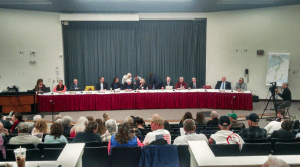By Darby Murnane & Emily Mokler Assistant Editor & Editor-in-Chief

The public forums provided a platform for discussion about the CMP powerline. (Photo by Emily Mokler)
Maine’s Department of Environmental Protection (DEP) hosted a week-long collection of hearings and two public forums on the UMF campus to address the proposed Central Maine Power (CMP) transmission line during the first week of April. This project, the New England Clean Energy Connect (NECEC), has been met with controversy from Maine residents as both those for and against the project have voiced concern over how the state’s actions will impact the course of climate change.
The transmission, according to The Portland Press Herald, will run 145 miles from the Canadian border just north of route 27 to Lewiston, ME, and approximately 50-55 miles of this would be newly constructed lines, the remaining distance consisting of existing lines that would be widened by 75-150 feet. Electricity generated by Quebec Hydropower would be carried to Massachusetts via the NECEC to aid MA. in meeting state green-energy standards. The transmission line is set to run directly through Farmington.
Many Mainers came forward during the public forums on April 2 and 4 to argue in favor of the line and implored the DEP panel members to take timely and productive steps to reduce greenhouse gas emissions. Speakers often cited the estimated 12 years the world has to take proactive steps in reversing climate change before it is too late.
The project is also meant to provide economic benefits to Mainers as workers will be needed for construction. Matt Marks, CEO of Associated General Contractors of Maine (ACG) spoke at the April 6 forum on behalf of his company to argue for the NECEC job opportunities, stating that AGC had lost 10,000 workers in recent recessions. “More than 5200 megawatts of oil, coal, and nuclear power plants will be retired from from 2013-2022. And another 5000 megawatts of coal and oil fire generation could retire in a couple years,” Marks said. “We need to replace these plants and 1200 megawatts of clean, reliable hydropower delivered to Lewiston, maine will be the region’s largest source of electricity from clean energy.”
Conversely, those speaking against the NECEC expressed fear that environmental damage and greenhouse gas emitted by the construction of the line will outweigh the proposed benefits. As an estimated 50-55 miles of land would be cleared to make way for the transmission line, environmentalist opponents argue that the deforestation and carbon dioxide (CO2) released from clear-cut vegetation essentially cancels out what CO2 is meant to be eliminated by the NECEC.
Tom Saviello, a former Maine Senator, also spoke at the April 6 forum, adding to the environmental debate with his expertise in forestry, having earned a Phd in Forest Resources from University of Maine. “One tree can absorb as much carbon a year that a car produces while driving 26,000 miles. Over the course of a life, a single tree can absorb one ton of carbon dioxide,” Saviello said. “So if we take the 55 miles of the corridor, that’s 150 feet wide and the rest 70 feet wide, we’ll cut a lot of trees which will equate to about 800,000 pounds of car carbon emissions.”
There was some discrepancy among speakers about how many trees would actually be cut as many in favor of the line argued that the supposedly pristine wilderness through which the line would run is already crossed by access roads, as well as stretches of working forests such as logging ground. Yet those against the line noted that logged forests are able to regrow, whereas land home to transmissions line are routinely sprayed with herbicides to keep vegetation at bay.
As Saviello testified before the DEP panel, he also commented on Maine’s legal responsibility in addressing climate via environmental law, stating, “We set goals for Maine, not New England. So I do suggest this part of the law should be addressed as part of the site location permit for [NECEC] can be issued.”